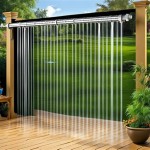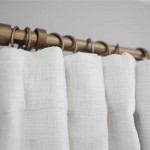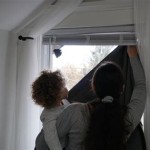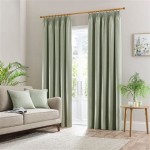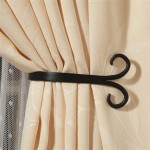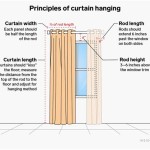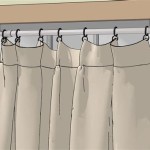Curtains That Block Heat And Light: An In-Depth Guide
The control of light and temperature within a residential or commercial space significantly impacts comfort, energy efficiency, and overall well-being. Curtains designed to block heat and light offer a practical and aesthetically pleasing solution to manage these environmental factors. These specialized curtains leverage various materials and construction techniques to minimize the transmission of solar radiation and visible light, creating a more comfortable and energy-efficient indoor environment.
This article will explore the different types of curtains designed to block heat and light, the materials used in their construction, the mechanisms through which they function, and the various factors to consider when selecting the appropriate curtains for a specific application. The goal is to provide a comprehensive understanding of these window treatments, enabling informed decisions regarding their selection and implementation.
Understanding the Mechanisms of Heat and Light Blocking
Curtains that effectively block heat and light operate on several core principles related to physics and materials science. The primary mechanisms include reflection, absorption, and insulation. Reflective properties are achieved through the use of light-colored or metallic backings that redirect incoming solar radiation away from the window. This reflection minimizes the amount of heat energy that enters the space directly. Absorption involves the curtain material capturing and retaining heat energy, preventing it from passing through into the room. This is often accomplished with darker-colored materials or dense weaves that increase the surface area available for absorption.
Insulation, on the other hand, focuses on reducing heat transfer through conduction, convection, and radiation. Multi-layered curtains or those with added linings create air pockets that act as insulation barriers, reducing the rate at which heat flows from the warmer side (outside) to the cooler side (inside). This insulation effect is particularly important during extreme weather conditions, helping to maintain a consistent indoor temperature and reduce reliance on heating and cooling systems. The effectiveness of any heat and light-blocking curtain depends on a combination of these mechanisms, with specific materials and construction techniques influencing the degree to which each mechanism contributes.
Ultimately, the ability of a curtain to block heat and light depends on its Optical Density. Optical density measures the amount of light that a material blocks. A higher optical density signifies better light-blocking capabilities. Light blocking curtains are often rated based on their optical density which is usually not stated on the product directly. However, this rating is a function of the material and the weave of the curtain, which influences the efficacy of blocking both heat and light.
Types of Curtains Designed to Block Heat and Light
Several types of curtains are available, each with varying degrees of effectiveness in blocking heat and light. Blackout curtains are perhaps the most well-known and are specifically designed to eliminate nearly all incoming light. These curtains often feature multiple layers, including a tightly woven fabric and a blackout lining. The lining is typically made of a dense, opaque material that prevents light from passing through. Blackout curtains are frequently used in bedrooms, home theaters, and other spaces where complete darkness is desired.
Thermal curtains are designed to minimize heat transfer. These curtains often incorporate multiple layers of fabric or a specialized thermal lining. The thermal lining acts as an insulating barrier, reducing heat gain during the summer and heat loss during the winter. While thermal curtains may not block as much light as blackout curtains, they offer significant energy savings by reducing the need for heating and cooling. Some thermal curtains also include a blackout layer for added light control.
Room darkening curtains represent a middle ground between blackout and standard curtains. These curtains are designed to reduce the amount of light entering a room, but they may not completely eliminate it. Room darkening curtains typically consist of a single layer of tightly woven fabric or a fabric with a light-reducing coating. They are suitable for spaces where some ambient light is desired, such as living rooms or dining rooms. The effectiveness of room darkening curtains can vary depending on the color and density of the fabric.
Insulated curtains combine the benefits of both thermal and light-blocking properties. They often feature multiple layers, including a face fabric, a thermal lining, and a light-blocking layer. Insulated curtains provide a comprehensive solution for managing both temperature and light levels within a space. They are particularly well-suited for rooms with large windows or those that receive direct sunlight.
Beyond these primary types, specialized curtains such as solar shades and cellular shades can also contribute to heat and light control. Solar shades are designed to filter out a portion of the sun's rays while maintaining some visibility. They are often used in commercial spaces or areas where natural light is desired but glare needs to be minimized. Cellular shades, also known as honeycomb shades, feature a unique cellular construction that creates air pockets for insulation. While not specifically designed as blackout curtains, cellular shades can significantly reduce heat transfer and light penetration.
Material Considerations: Fabric, Linings, and Coatings
The materials used in the construction of heat and light-blocking curtains play a crucial role in their performance. Different fabrics offer varying degrees of light absorption, heat reflection, and insulation. The choice of lining and any additional coatings further enhances these properties.
Polyester is a common fabric choice for curtains due to its durability, affordability, and wrinkle resistance. Polyester fabrics can be woven tightly to provide good light-blocking capabilities. They also offer some degree of thermal insulation, particularly when combined with a lining. Microfiber polyester is an even tighter weave that provides an enhanced effect of heat blocking. This material is generally used in warmer climates because it tends to trap hot air inside.
Cotton is another popular fabric option known for its natural look and feel. Cotton fabrics can be treated with coatings or combined with linings to improve their light-blocking and thermal insulation properties. However, cotton is more prone to wrinkles and may require more maintenance than polyester.
Velvet is a dense and luxurious fabric that offers excellent light-blocking and thermal insulation. The thick pile of velvet absorbs light and creates an insulating barrier. Velvet curtains are often used in bedrooms or home theaters where a high degree of darkness is desired.
Acrylic fabrics are known for their resistance to fading and their ability to withstand outdoor conditions. While not as common as polyester or cotton for interior curtains, acrylic fabrics can be used for curtains in sunrooms or other areas that receive a lot of direct sunlight.
Linings are an essential component of heat and light-blocking curtains. Blackout linings are typically made of a dense, opaque material such as rubber or vinyl. These linings prevent nearly all light from passing through the curtain. Thermal linings are designed to provide insulation and reduce heat transfer. They may be made of materials such as foam, felt, or a composite fabric with a metalized backing. Coatings can also be applied to fabrics to enhance their light-blocking or thermal insulation properties. For example, a coating of acrylic or polyurethane can make a fabric more opaque and water-resistant.
The color of the fabric also influences its ability to block heat and light. Darker colors tend to absorb more light and heat, while lighter colors reflect more light and heat. For optimal heat and light blocking, it is generally recommended to choose curtains with a dark-colored lining and a light-colored face fabric. This combination allows the lining to absorb any remaining light while the face fabric reflects heat away from the window. However, aesthetic preferences also play a role in the color selection process, and compromises may be necessary to achieve the desired balance between functionality and appearance.
Installation Techniques and Additional Considerations
Proper installation is critical to maximizing the effectiveness of heat and light-blocking curtains. Curtains should be installed as close to the window as possible to minimize gaps through which light and heat can enter. Using a wraparound curtain rod can help to further reduce light leakage by extending the curtains beyond the edges of the window frame. The length of the curtains should also be considered. Curtains that extend to the floor or even slightly beyond can provide better insulation and light blocking than shorter curtains.
In addition to the curtains themselves, other factors can contribute to heat and light control. Window films can be applied to the glass to reduce solar heat gain and glare. These films are available in various tints and levels of reflectivity. Weatherstripping can be used to seal gaps around windows and doors, preventing air leaks and improving energy efficiency. Landscaping can also play a role in reducing heat gain by providing shade for windows. Trees, shrubs, and vines can block sunlight and cool the air around a building.
The selection of appropriate curtains depends on the specific needs and priorities of the user. Factors to consider include the amount of light and heat that needs to be blocked, the desired level of privacy, the aesthetic style of the room, and the budget. For spaces where complete darkness is required, such as bedrooms or home theaters, blackout curtains are the best option. For spaces where energy efficiency is a primary concern, thermal curtains or insulated curtains are recommended. For spaces where some ambient light is desired, room darkening curtains or solar shades may be suitable.
Maintenance is necessary to prolong the life and performance of heat and light-blocking curtains. Regular dusting or vacuuming can prevent the accumulation of dirt and debris that can reduce the effectiveness of the curtain. Curtains should be washed or dry-cleaned according to the manufacturer's instructions. Avoid using harsh chemicals or bleach that can damage the fabric or lining. Proper storage can also help to prevent damage or fading. When not in use, curtains should be stored in a clean, dry place away from direct sunlight.

Deconovo 2 Panels Blackout Curtains 52x63 In Thermal Insulated Burlywood Wal Com

The Best Curtains To Keep Heat Out Year Round Shade

Deconovo Soundproof Blackout Curtains Thermal Insulated Noise Reducing 2 Panels 52x45 In Light Gray Wal Com

The Best Curtains To Keep Heat Out Year Round Shade

Do Blackout Curtains Keep Out Heat Time Curtain

How To Block Light Leaking From The Top And Sides Of Your Curtains

Cool Your Home Naturally How Curtains Reduce Heat

Deconovo 52x84 In Curtains 100 Blackout Energy Efficient Soundproof 2 Panels Heat And Cold Insulated Dark Brown Wal Com

The Best Curtains To Keep Heat Out Year Round Shade

Thd Grant 100 Full Complete Blackout Heavy Thermal Insulated Energy Saving Heat Cold Blocking Curtain Drapery

